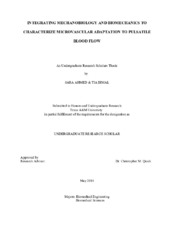| dc.description.abstract | Continuous-flow left-ventricular assist device (LVAD) implantation leads to increased peripheral resistance and development of arteriovenous malformations. These comorbidities have resisted mechanistic explanation, because normal microvascular adaptation has not yet been fully characterized. In fact, standard mathematical models using the common assumption that vessels solely adapt to steady flow do not reproduce normal vascular structure. Therefore, we developed a simple, mathematical model of a branching microvascular network to test the hypothesis that pulsatile flow is necessary for microvascular stability. First, we assumed a microvascular network with asymmetric fractal geometry. Second, we predicted pulsatile shear stresses using the standard transmission-line equations, typically used to characterize pulse transmission in large conductance arteries. Third, we assumed radii increase linearly with pulsatile endothelial shear stress. Evaluating the model iteratively to simulate the adaptive process yielded stable microvasculature with normal radii. Decreasing inlet pulsatility led to decreasing vessel radii and capillary rarefaction, both of which raise microvascular resistance. In extreme cases, decreased pulsatility leads to a lack of capillaries and formation of an arteriovenous malformation. Identifying the fundamental cause of the devastating complications of LVAD implantation arose from integrating the typically isolated fields of biomechanics and mechanics, and translating basic research at the level of a single vessel to clinically relevant research at a systemic level. | en |


